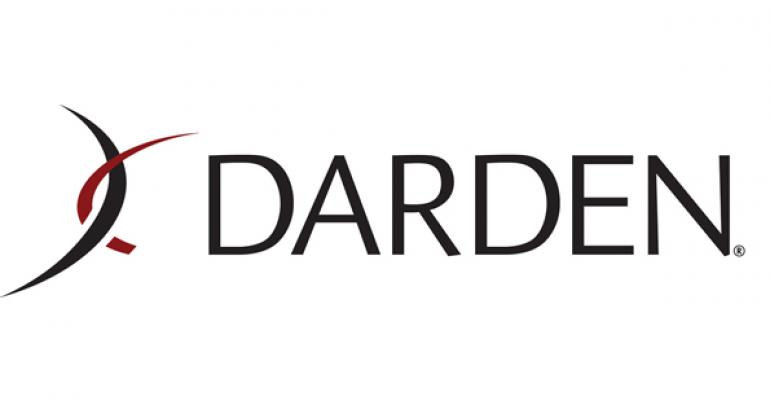Darden Restaurants Inc. increased its sales outlook for the 2016 fiscal year as combined same-store sales for its seven brands rose 1.6 percent during the second quarter ended Nov. 23, the company said Friday.
Same-store sales at Darden’s flagship Olive Garden brand increased 1 percent, and LongHorn Steakhouse same-store sales rose 2.6 percent during the quarter.
The performance was strong enough for Darden to increase its same-store sales guidance for the full year to 2.5 percent to 3 percent, from 2 percent to 2.5 percent. It also increased earnings expectations for the full year. The company’s stock price rose 7 percent in Friday morning trading.
“We significantly outperformed the industry,” Darden CEO Gene Lee said during an earnings call Friday morning. He noted that the company’s same-store sales were actually better when compared on a more consistent calendar with the previous quarter.
The second quarter of 2014 had an extra week. On a calendar basis, Darden’s sales rose 2.9 percent for all of its brands. Olive Garden’s same-store sales rose 2.8 percent and LongHorn’s sales increased 3.6 percent. Same-store sales rose 5.8 percent at Bahama Breeze, 3.8 percent at Seasons 52, 2.4 percent at Yard House, 3.2 percent at Eddie V’s and 0.9 percent at The Capital Grille.
“Consumers have been consistent quarter to quarter,” Lee said. “They’re buying a little less on a deal. They’re using the whole menu: They’re buying appetizers, they’re buying desserts and they’re buying high-value options.”
But Lee suggested that labor costs could rise in the coming year due to a combination of minimum wage increases and competition for labor.
Darden said it expected higher minimum wage rates that take effect on Jan. 1 to increase its hourly wages by 1.2 percent. The company’s breadth is minimizing the impact of those increases because its locations aren’t concentrated in states where wages are increasing.
In addition, Darden expects that lower unemployment could increase competition for labor and increase pressure on wage rates in the future, although, Lee said, “We are not seeing a whole lot of wage inflation” at the moment.
The casual-dining segment benefits when wage rates overall increase, he noted.
“Historically, when there has been wage pressure and wage growth, that has been good for demand at the casual dining business,” he said. “Wage growth is much more favorable than discretionary income.”
Darden is coming off the spinoff of its real estate into a real estate investment trust, Four Corners Property Trust. The company has 1,534 total locations, including 844 Olive Garden restaurants and 479 LongHorn units, with the rest spread among The Capital Grille, Bahama Breeze, Seasons 52, Eddie V’s and Yard House.
The company did not say whether it would consider another plan to increase shareholder value. Starboard Value LP, which won a proxy fight to control Darden’s board more than a year ago, has said in the past that the company should consider spinning off some of its specialty brands or franchising.
Lee didn’t rule out another move, but he said the company is operating as if it will remain as is. “Our primary focus is on running the business at a very high level,” he said. “Management team and the board will regularly evaluate alternatives to manage the company effectively.”
Revenue in the second quarter increased 3.2 percent, to $1.61 billion, from $1.56 billion in the same quarter a year ago. Net earnings increased to $43.2 million, or 34 cents per share, an increase from a loss of $32.8 million, or 26 cents per share, a year ago.
Olive Garden’s same-store sales in the second quarter were due mostly to increases in pricing and in customers’ more expensive orders, although with some higher traffic on a comparable calendar basis. Traffic grew 0.9 percent, while pricing increased 1 percent in the quarter, and menu mix, or customers’ cost of orders, rose 0.9 percent.
Similarly, traffic at LongHorn increased 1.5 percent for the same 53 weeks in the quarter, while pricing increased 2.3 percent.
Olive Garden implemented tabletop tablets systemwide, executives said during the call, which improved the customer experience. The company also saw some success for its OG To Go business.
The take-out business has increased 30 percent over the past two years and now represents more than 10 percent of the brand’s sales, Lee said. That’s a key element for Olive Garden because to-go orders improve its convenience.
“When we started, we thought 20 percent was a good target,” Lee said, noting that 20 percent of average unit volumes of $4 million at Olive Garden would represent substantial sales per location. “We’re at over 10 percent now and growing very rapidly.”
Darden is studying the prospect of delivery, which Lee said would work well with Olive Garden’s menu. “The cuisine we serve at Olive Garden travels extremely well,” he said.
Yet the company doesn’t know which delivery provider it would work with, noting that the business is fragmented at the moment. Lee said about half of the company’s Olive Garden locations are covered by some sort of third-party delivery company, such as Postmates or Google.
“We believe there is going to be some sort of massive change in third-party delivery,” he said, adding that Darden will partner with the provider it believes will be the “clear winner.”
“We’re not sure it’s as productive as it can be,” Lee said, adding that Darden has delivery tests in the works. “A fragmented system is not going to be the way to go.”
Contact Jonathan Maze at [email protected].
Follow him on Twitter: @jonathanmaze





